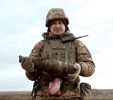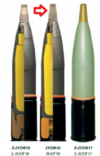Eggburt1969
Well-Known Member
Little weekend quiz for a munition ID-minded person. Let's see who can ID this projectile.
I've got an idea what it is, but lets see if someone else can ID it.
Only clue I'll give, which may be wrong, is that it's possibly not being used in its original intended environment.
Original image is from the X (Twitter) post linked below.
I've got an idea what it is, but lets see if someone else can ID it.
Only clue I'll give, which may be wrong, is that it's possibly not being used in its original intended environment.
Original image is from the X (Twitter) post linked below.


